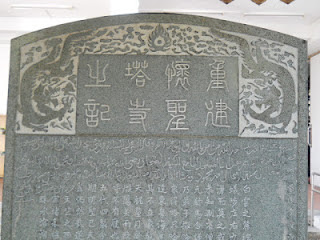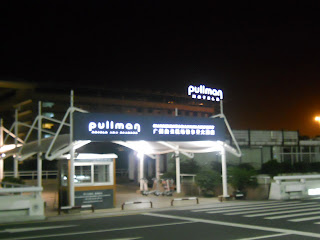 Shameen or Shamien Island is an artificial island formed of sand as the name implies,'Sha'-mandarin word for sand while 'Mien'means surface.
Shameen or Shamien Island is an artificial island formed of sand as the name implies,'Sha'-mandarin word for sand while 'Mien'means surface.In this old aerial photo,the island is located to the south of the western suburb of Guangzhou city beside the Zhujiang River or Pearl River in Liwan District.
An irregular oval, it is about half a mile in length by some three hundred yards in breadth, and comprises two Concessions: one British and the other French.
This is the home for foreign residents in Canton since 1863.
Following a 1757 Imperial Edict by Chinese Manchu Emperor Qianlong, foreign trade—and therefore its communication with the outside world—was prohibited outside of a tiny enclave called the “Thirteen Factories.”
The Factories(Chinese Merchants) were located on a small stretch of the Zhujiang (Pearl) River in the west suburbs of Canton outside of the walled city, which foreigners were not permitted to enter.
The thirteen appointed Chinese merchants (or Factors) were responsible for the foreigners’ behavior.
One such regulations is that only male foreigners were allowed in Canton, and they were only permitted to stay for the duration of the trade season (6 months a year) after which they were required to leave China—either for Macau or back to Europe.
Western style building architectures,Our Lady of Lourdes Chapel,Christchurch and the many beautiful tree lined boulevard were some of the features of the island.
The White Swan Hotel which is a luxury hotel having hosted to many high ranking foreign dignitaries is adjacent to the United States Consulate Office.
Huangsha Station of Guangzhou Metro is located within a short walk from the island, via an overpass crossing the busy Liu'ersan Road.
There is also a ferry running from Huangsha Pier to Fangcun Pier, which runs every 10 minutes carrying foot-passengers and bicycles. Fares are from 0.5RMB for a foot passenger and 1RMB for a passenger with a bike.
There are no public buses on the island itself, although there are several nearby bus stops. Guangzhou Cultural Park (文化 pinyin:Wen Hua) bus stop is east of Shamien and nearest.
It took me close to an hour to walk leisurely from Zhongsan 6th Road to reach the Pearl River bank.
After crossing onto Zhongsan 7th Road,made a left turn to Renmin Zong Lu,the olden days shophouses were still intact and business activities were very lively
.Almost every corners of the street have surveillance CCTV and this is a very safe city.
Had a simple 6 Yuan mixed-riced dinner where you need to buy a coupon and then pick your dishes.
Public buses were still jammed packed after office hours.
Bus Number 37 route ends at Guangzhou Rail Station and Bus 823 headed Lihua Coach Terminal beside the rail station.
After passing by Guangzhou Children's Hospital and the 5 Rams City Hotel(a three star ,room rates between US38-USD85),noticed a night bazaar in one of the side streets.
Bai Gong(White House) Hotel is behind Zhongsan University Hospital II. Another Xin Ling Hotel is beside some sea-food hawker street.
Most of the businesses centred near the Pearl River are mainly electronic consumer goods such as this Electronic and Digital City Building. Another big wholesale electronic business is in the Nanjiang International Digital Building.

The Zhujiang River (Pearl River) flows out via the Zhujiang Estuary near Shenzhen and Lantau Island in Hong Kong and then into the South China Sea.
This RenMin(People's) Bridge connects to Haizu District which is an Island by itself and Shamien Island is beside the bridge on the right(not in photo)
Hotels in Haizhu District:
1) South American Grand Hotel(No. 16 Haiming street Binjiang West Road)-82USD
2) Riverview Hotel (No. 298 Yan Jiang Zhou Road) -72USD
3) Zhuying Garden Hotel (No.354 Xinggang Zhong Road, inside the Pearl Film Making company,Beside the Kecun subway station exit D) -41USD
4) New Pearl River Hotel (No:795 Bingjiang East Road) -77USD
5) Guangzhou Tianyue Hotel (NO:1 Jili South Street) -37USD
6) Guangzhou Huahai Hotel (No.232 Jiang Nan Avenue) -33USD
7) Plaza Canton Hotel (Rosedale) No.348 Jiang Nan Road -77USD
8) Guangzhou Xingdu Hotel (No:172 Middle Changgang Road) -39USD
9) Paco Business Hotel [NO.438 Jiangnan Avenue (Jiangnan Dadao)] -30USD
10) Guangzhou Hongdu Hotel (No.53, Yiju Street, South Island Road) -25USD
11) Ai Du Hotel ( No.1441 Dongxiao South road) -25USD
Places in Haizhu District that might interest you:
Zhongda Fabric Market,main campus of Sun Yat Sen University,Museum of Biology Zhongsan University,Guangzhou International and Exhibition Center,Zhujiang Water Fun Park,Xiaogang Park,Wufeng Mountain,Yingzhou Ecology Park,Henan Christian Church,Guangzhou Pagoda and Zhouzhoule Mass Cultural Square.

A beautiful European styled building currently being used as an electronic shopping plaza.
Chinese cities were planned as segregated environments, with separate districts for different purposes.
The official headquarters, usually in the north central area of the city, faced south over their subjects.
Wide avenues separated residential wards from each other, and these wards often had gates.
Market places were spread through the inner city, but much of the mercantile activity took place outside the city walls.

There were dozens of luxuriuos cruise ships taking tourists for a ride down the Pearl River.
The night sceneries along the banks of the Pearl River was very spectacular and gorgeous.
My current location is Xidi Wharf where there is a ticketing booth nearby.
Cruising time:19:30,20:00,20:30,21:00,21:30 and 22:00.
Ticket price:1st Floor(38Yuan),2nd Floor(48Yuan) and Upper Deck(58Yuan)
During the day,there were ships cruising between Xidi Wharf and Aozhou Wharf.
Sailing time:09:00 - 11:00 and between 17:00 - 18:30.
The fares were 0.50Yuan per head,0.60Yuan per bicycle and 0.25Yuan for senior citizens above 65 years.

The historical Marine Custom House which must be the centrepoint of The First Opium War or the First Anglo-Chinese War that was fought between the British East India Company and the Qing Dynasty of China from 1839 to 1842 with the aim of forcing China to allow free trade, particularly in opium.
During the 19th century, trading in goods from China was extremely lucrative for Europeans and Chinese merchants alike.
Due to the Qing Dynasty's trade restrictions, whereby international trade was only allowed to take place in Canton (Guangzhou) conducted by imperially sanctioned monopolies, it became uneconomic to trade in low-value manufactured consumer products that the average Chinese could buy from the British like the Indians did.

A night to chill out with Heineken beer at this outlet beside the Pearl River.
Guangzhou Asia Pacific Brewery Co. Ltd (GAPB) greenfield brewery factory is in the Huangpu District of Guangzhou City, Guangdong.
View of Pearl River from Renmin Bridge,The other bridge downstream is Jiefang Bridge,then the Haizhu Bridge near Tianzi Pier and the big Haizhu Wholesale Flea Market Square.
Pearl River,the third longest river in China has a length of more than 1,376 miles (2,124 kilometers).
Originating from a calcareous cave at Mahongshan, Qujing city, Yunnan province, the Pearl River runs across Yunnan, Guizhou, Guangxi and Guangdong provinces,Hong Kong and eventually flows into South China Sea.
With sparkling lights on both banks of the river, modern buildings and several old bridges reflect themselves on the water surface, Pearl River Cruise creates a romantic atmosphere and leaves unforgetable impression to every visitor.

Cruise ship heading towards Tianzi Wharf,the most popular disembarkation port .
It owns more luxurious ship and better tasted buffet dinner.
Address: Beijing South Road, Guangzhou
Bus Route: 1, 4, 57, 59, 64, 194, 183, 194, 219, 281, 544 Metro Station:
Getting off at Haizhu Square Station, Line 2, Exit A
Cruise ship Nanhai Sen 80 minutes extravangaza:(cruise time from 18:55-20:05)
Deck 1F:Dinner only (USD30),Deck2F VIP Western Dinner (USD48),Rooftop deck -Snacks,tea,coffee (USD48)

Tips on how to use the Public buses in Guangzhou.
You'll see this route signboard at almost all bus stop shelters.
Don't worry if you can't read the mandarin script. This bus route map is at Ximenkou,
Zhongsan 6th (Liu) Lu and has red wording being your current position.
Since most of the buses are left hand drive,the route correspond to their driving directions.
Take Bus 104,there are still 10 more stops before it ends where all passengers will get off the bus.
If you would like to have a city ride,try hopping into any of them but not Bus 193 where you have only two more stops before ending.
Just get ready your 1Yuan notes or coins and put it into the deposit slot beside the driver,no questions asked and enjoy the ride.
Hopefully you are lucky to have a seat otherwise just hang on throughout the journey. Once you've reached that destination get off the bus and check your map to learn more about the place including the Mandarin scripts.
Look at Bus 233,on top of the many bus stops were red icons meaning Metro Station stops.






























